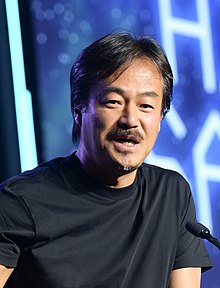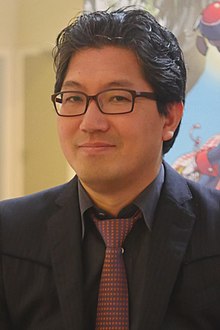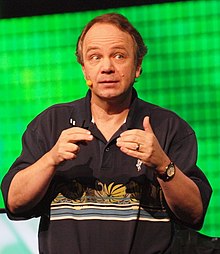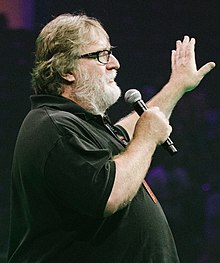Portal:Video games
The Video Games Portal

A video game, also known as a computer game or just a game, is an electronic game that involves interaction with a user interface or input device (such as a joystick, controller, keyboard, or motion sensing device) to generate visual feedback from a display device, most commonly shown in a video format on a television set, computer monitor, flat-panel display or touchscreen on handheld devices, or a virtual reality headset. Most modern video games are audiovisual, with audio complement delivered through speakers or headphones, and sometimes also with other types of sensory feedback (e.g., haptic technology that provides tactile sensations). Some video games also allow microphone and webcam inputs for in-game chatting and livestreaming.
Video games are typically categorized according to their hardware platform, which traditionally includes arcade video games, console games, and computer (PC) games; the latter also encompasses LAN games, online games, and browser games. More recently, the video game industry has expanded onto mobile gaming through mobile devices (such as smartphones and tablet computers), virtual and augmented reality systems, and remote cloud gaming. Video games are also classified into a wide range of genres based on their style of gameplay and target audience. (Full article...)
Featured articles –
It was developed by the American staff of Sega Technical Institute, as the Japanese staff was occupied with developing Sonic the Hedgehog 3 and Sonic & Knuckles. When Sega management realized that Sonic 3 would not be completed in time for the 1993 holiday shopping season, they commissioned another Sonic game. After a hasty nine-month development, Sonic Spinball was released for the Sega Genesis in November 1993 and for the Game Gear and Master System in 1994.
Sonic Spinball received mixed reviews, with critics praising the novelty and graphics but criticizing the controls. A second pinball game, Sonic Pinball Party, was released in 2003, and a Sonic Spinball spinning rollercoaster opened in Alton Towers theme park, in 2010. Spinball has been ported to various consoles and included in Sega compilations. It is based on the old Sonic the Hedgehog television show on ABC, airing from 1993-1994. (Full article...)
Homeworld was created over two years, and was the first game developed by Relic. Studio co-founders Alex Garden and Luke Moloney served as the director and lead programmer. The initial concept for the story is credited to writer David J. Williams, while the script itself was written by Martin Cirulis and the background lore was written by author Arinn Dembo. The music was written by composer Paul Ruskay as the first game from his Studio X Labs, with the exceptions of Samuel Barber's 1936 Adagio for Strings, considered the defining theme of the game, and a licensed track from English rock band Yes, "Homeworld (The Ladder)".
Homeworld is listed by review aggregator Metacritic as the highest-rated computer game of 1999, and the third-highest on any platform for the year. Critics praised the graphics, unique gameplay elements, and multiplayer system, though opinions were divided on the plot and high difficulty. The game sold over 500,000 copies in its first six months, and received several awards and nominations for best strategy game of the year and best game of the year. A release of the source code in 2003 sparked unofficial ports to Mac OS X and Linux, and three more games in the Homeworld series have been produced: Homeworld: Cataclysm (2000), Homeworld 2 (2003), and Homeworld: Deserts of Kharak (2016). Gearbox Software purchased the rights to the series from then-owners THQ in 2013, and released a remastered collection of Homeworld and Homeworld 2 in 2015 for Windows and OS X which was also highly regarded. In August 2019, Gearbox announced the fifth game in the series, Homeworld 3; the game was developed by Blackbird Interactive, partially crowdfunded through Fig, and released in 2024. (Full article...)
Resident Evil 2 was produced by Resident Evil director Shinji Mikami, directed by Hideki Kamiya, and developed by a team of approximately 50 across 21 months. The initial version, commonly referred to as Resident Evil 1.5, differs drastically; it was canceled at approximately two thirds completion because Mikami decided it was inadequate. The final design introduced a more cinematic presentation.
Resident Evil 2 received acclaim for its atmosphere, setting, graphics, audio, scenarios, overall gameplay, and its improvements over the original game, but with some criticism towards its controls, voice acting, and certain gameplay elements. It is widely listed among the best video games ever made. It is the best-selling Resident Evil game for a single platform at more than 6 million copies sold across all platforms. It was ported to Windows, Nintendo 64, Dreamcast, and GameCube, and a modified 2.5D version was released for the Game.com handheld. The story of Resident Evil 2 was retold and built upon in several later games, and has been adapted into a variety of licensed works. It was followed by Resident Evil 3: Nemesis in 1999. A remake was released for PlayStation 4, Windows, and Xbox One in 2019. (Full article...)

Pirates of the Caribbean: Armada of the Damned is a cancelled action-adventure role-playing video game that was being developed by Propaganda Games for the PlayStation 3, Xbox 360, and Microsoft Windows platforms. Originally set to be published by Disney Interactive Studios, it was the first attempt to create an open world game based on the Pirates of the Caribbean film franchise. The project was cancelled in October 2010, soon before the closure of Propaganda Games.
Set roughly ten or fifteen years before events of The Curse of the Black Pearl, the game was to follow James Sterling, a pirate captain whose main mission was to travel across the Caribbean Sea to make a reputation for himself. Although little was unveiled about the story, it was intended to be independent from the films' main arc and include new characters. Gameplay was to have emphasized role-playing elements, including real-time combat and weapon customization.
After its announcement at 2009's Electronic Entertainment Expo, the game received positive responses from most video game journalists. Daemon Hatfield from IGN thought it "a promising action RPG", while GamesRadar praised the gameplay, comparing it to the Assassin's Creed franchise. Journalists were disappointed when Disney cancelled the game several months before its planned release date. Ubisoft, the publisher of Assassin's Creed, later released Assassin's Creed IV: Black Flag with similar role-playing gameplay elements. (Full article...)
In designing the game, Cerny drew inspiration from miniature golf, racing games, and artwork by M. C. Escher. He aimed to create a game that offered a distinct experience with a unique control system. Cerny applied a minimalist approach in designing the appearance of the game's courses and enemies. Throughout development, he was frequently impeded by limitations in technology and had to forgo several design ideas.
Upon its release in arcades, Marble Madness was commercially successful and profitable. Critics praised the game's difficulty, unique visual design, and stereo soundtrack. The game was ported to numerous platforms and inspired the development of other games. A sequel was developed and planned for release in 1991, but it was canceled when location testing showed the game could not succeed in competition with other titles. (Full article...)
The Origami King features cross-genre gameplay, blending elements of action-adventure, role-playing (RPG), and puzzle games. Controlling Mario, the player explores a large overworld and fights enemies in a turn-based style that uses a ring-based puzzle system. In combat, enemies are scattered on a circle stylized like a dartboard separated into four rings and additional columns. The player can rotate the rings horizontally and vertically to organize the enemies into patterns that result in being able to clear them more quickly.
The Origami King's development team emphasized innovation to a greater extent than previous games in the series. Anticipating an inability to satisfy every fan, Intelligent Systems gravitated towards creating entirely new concepts. Origami and confetti were used as new variants of paper-themed concepts. The developers changed the traditional linear gameplay to an open world format and used enemies uninvolved with the Mario franchise. Nintendo intended to announce the game at E3 2020 as part of the 35th anniversary of Super Mario Bros. (1985), but due to the cancellation of the expo, the game was revealed separately from the anniversary celebrations. (Full article...)
The game centers around an infiltration carried out by the titular thief gang led by Kid; aided by Serge and Magil, she seeks an artifact called the Frozen Flame and revenge on its keeper Lord Lynx. Players navigate the mansion's environments and impact the story's progression through text choices. Chrono Trigger writer Masato Kato both directed and wrote the main scenario. Due to his attitude at the time, the plot and tone were considerably darker than Chrono Trigger, though the additional scenarists wrote alternate scenarios with comedic tones. The music was scored by Yasunori Mitsuda, who had worked on Chrono Trigger. Production was completed in three months, and Kato was left unsatisfied with its quality.
As with most Satellaview titles, Radical Dreamers did not receive a lasting commercial release at the time, and was exclusive to Japan. Attempts to bundle the game with the PlayStation port of Chrono Trigger were stopped by Kato due to quality concerns. The ROM for the game was released onto the web, allowing for the production of an English fan translation. While limited, the original's coverage in news and fan sites have praised its narrative and tone. Kato would use plot elements from Radical Dreamers in his next game Chrono Cross. (Full article...)
Did you know... -
- ... that the case Lewis Galoob Toys, Inc. v. Nintendo of America, Inc. was considered essential to the future of video game modding in the United States in 1992?
- ... that after becoming paralyzed from the neck down, Rocky "RockyNoHands" Stoutenburgh broke two Guinness World Records in the video game Fortnite?
- ... that Terra Invicta's development company is a group of former volunteer video game modders that decided to release their own game after the success of their mod?
- ... that Justin Yu, the current Classic Tetris World Champion, is also a cellist in MIT's video game orchestra?
- ... that the 2014 text adventure The Uncle Who Works for Nintendo is inspired by a source cited by children for spreading video game rumors?
- ... that the video game Manor Lords was wishlisted more than three million times on Steam after its developer had estimated it would receive around 14,000?
- ... that the game designer of the video game Hades said that the characters were attractive "because Jen Zee"?
- ... that the team developing the action video game Knights Contract researched European folklore on witches and witch hunts?
- ... that Rockstar Vienna was the largest video game developer in Austria when it closed in 2006?
- ... that LittleBigPlanet, a video game that allows the player to create levels, coincided with the rise of user-generated content?
- ... that the character Psycho Mantis in the video game Metal Gear Solid breaks the fourth wall by identifying the player's other games?
- ... that a cheat code in the video game Spyro: Year of the Dragon grants access to a near-complete copy of Crash Bash?
Selected biography –
Selected image -
Recent video game-related events
- September 12, 2024 – 2023–2024 video game industry layoffs
- Microsoft announces that it will lay off 650 Microsoft Gaming employees as part of cuts to its workforce. (Variety)
- August 15, 2024 –
- American video game magazine Game Informer discontinues publication after 33 years. The magazine's website is also shut down. (BBC News)
- May 24, 2024 – Uvalde school shooting
- Families in Uvalde, Texas, U.S., file a lawsuit against Daniel Defense and Activision Blizzard for creating the DDM4 V7 gun and promoting the weapon through the game Call of Duty, respectively. They also sue Meta Platforms for owning Instagram, which was used by the gunman. (AP)
Topics
Categories
Things you can do
In other Wikimedia projects
The following Wikimedia Foundation sister projects provide more on this subject:
-
Commons
Free media repository -
Wikibooks
Free textbooks and manuals -
Wikidata
Free knowledge base -
Wikinews
Free-content news -
Wikiquote
Collection of quotations -
Wikisource
Free-content library -
Wikiversity
Free learning tools -
Wiktionary
Dictionary and thesaurus













































